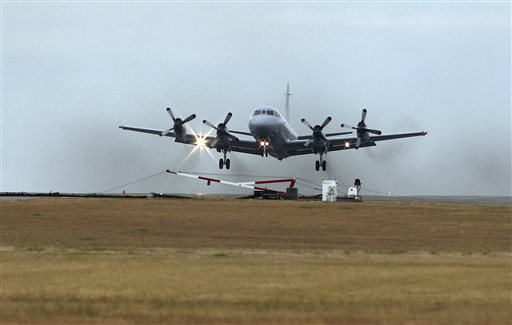KUALA LUMPUR, Malaysia (AP) — As frustration was setting in, calmer seas returned Wednesday and the search for the remains of Flight 370 began anew in remote waters of the Indian Ocean off western Australia.
Gale-force winds that forced an all-day delay Tuesday died down, allowing a total of 12 planes and two ships from the United States, China, Japan, South Korea, Australia and New Zealand to resume the hunt for any pieces of the Malaysia Airlines jet — tangible evidence for the families seeking closure after more than two weeks of anguished uncertainty.
Although officials sharply narrowed the search zone based on the last satellite signals received from the Boeing 777, it was still estimated at 1.6 million square kilometers (622,000 square miles), an area bigger than Texas and Oklahoma combined.
Australian Prime Minister Tony Abbott told Nine network television on Wednesday: “We’re throwing everything we have at this search.”
“This is about the most inaccessible spot imaginable. It’s thousands of kilometers from anywhere, but nevertheless, we are the closest nation. We are a capable nation. We will do what we can to solve this riddle,” he later told Seven Network television.
The Australian Maritime Safety Authority, which coordinates the search on Malaysia’s behalf, said Wednesday’s search will focus on 80,000 square kilometers (30,900 square miles) of ocean. The search area is about 2,500 kilometers (1,550 miles) southwest of Perth.
Australia’s deputy defense chief, Air Marshal Mark Binskin, told reporters Tuesday in Perth, the Australian west coast city that is the staging point for the search, that it is a massive challenge.
“We’re not searching for a needle in a haystack — we’re still trying to define where the haystack is,” he said.
Various pieces of floating objects have been spotted southwest of Perth, but none have been retrieved. If they are found to be from the plane, that may help investigators narrow the search for the wreckage of the plane.
Malaysia announced Monday that an analysis of satellite data received after Flight 370 left Kuala Lumpur for Beijing on March 8 indicated the plane had gone down in the Indian Ocean, killing all 239 people aboard.
But that finding did not answer troubling questions about why the plane was so far off-course. China, home to 153 of the passengers, demanded that Malaysia turn over the satellite data used to determine the plane’s fate.
The airline’s chairman, Mohammed Nor Mohammed Yusof, said it may take time for further answers to become clear.
“The investigation still underway may yet prove to be even longer and more complex than it has been since March 8th,” he said.
The search for the wreckage and the plane’s flight data and cockpit voice recorders could take years because the ocean can extend to up to 7,000 meters (23,000 feet) deep in some parts. It took two years to find the black box from an Air France jet that went down in the Atlantic Ocean on a flight from Rio de Janeiro to Paris in 2009, and searchers knew within days where the crash site was.
There is a race against the clock to find Flight 370’s black boxes, whose battery-powered “pinger” could stop sending signals within two weeks. The batteries are designed to last at least a month.
David Ferreira, an oceanographer at the University of Reading in Britain, said little is known about the detailed topography of the seabed where the plane is believed to have crashed.
“We know much more about the surface of the moon than we do about the ocean floor in that part of the Indian Ocean,” Ferreira said.
The satellite information did not provide an exact location — only a rough estimate of where the jet went down, and Defense Minister Hishammuddin Hussein said the data is still being analyzed “to attempt to determine the final position of the aircraft” and that an international working group of satellite and aircraft performance experts had been set up.
The lack of physical evidence and what is thought to be a lack of reliable information from Malaysian officials has resulted in a torrent of criticism from relatives of the passengers.
In Beijing on Tuesday, nearly 100 relatives and their supporters marched to the Malaysian Embassy, where they threw plastic water bottles, tried to rush the gate and chanted, “Liars!”
Many wore white T-shirts that read “Let’s pray for MH370.” They held banners and shouted, “Tell the truth! Return our relatives!”
Police briefly scuffled with a group of relatives who tried to approach journalists. The relatives demanded to see the Malaysian ambassador, and they later met with him.
In a clear statement of support for the families, Chinese President Xi Jinping ordered a special envoy to Kuala Lumpur to deal with the case, and Deputy Foreign Minister Xie Hangsheng told Malaysia’s ambassador that China wanted to know exactly what led to the announcement that the plane had been lost, a statement on the ministry’s website said.
The conclusions were based on an analysis of the brief signals the plane sent every hour to a satellite belonging to Inmarsat, a British company, even after other communication systems on the jetliner shut down for unknown reasons.
Investigators will be looking at various possibilities, including mechanical or electrical failure, hijacking, sabotage, terrorism or issues related to the mental health of the pilots or someone else on board.
“We do not know why. We do not know how. We do not know how the terrible tragedy happened,” Malaysia Airlines’ chief executive, Ahmad Jauhari Yahya, told reporters.
___
McGuirk reported from Canberra, Australia. AP writers Scott McDonald and Eileen Ng in Kuala Lumpur; Christopher Bodeen and Didi Tang in Beijing; Danica Kirka in London; and Kristen Gelineau in Sydney contributed to this report.

COMMENTS
Please let us know if you're having issues with commenting.